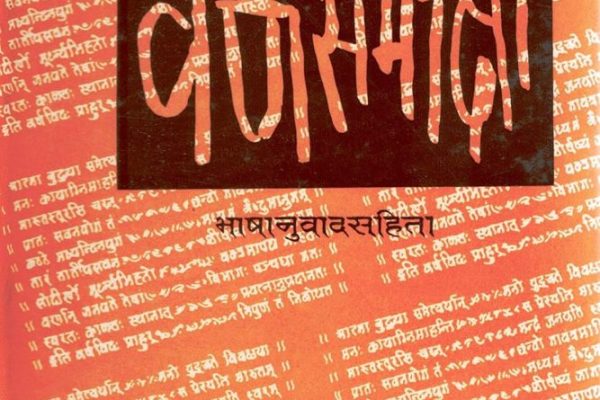Report: National Seminar on Sharirikavimarsha
Shri Shankar Shikshayatan organised a National Seminar on Pandit Madhusudan Ojha’s work on Brahmavijnana, Sharirikavimarsha, on May 30, 2023. The seminar focussed on four chapters of the book. The main speakers included Prof. Dharanidharan of the University of Pondicherry, Prof. Ganapati Bhatt, of Rashtriya Sanskrit University, Tirupati, Dr. Ram Chandra Sharma of Shri Lal Bahadur Shastri Rashtriya Sanskrit University, New Delhi and Dr. Devesh Kumar Mishra of Indira Gandhi Open University, New Delhi. The meeting was chaired by Professor Santosh Kumar Shukla of Jawaharlal Nehru University, New Delhi. Sharirikavimarsha is an important work on advaita vedanta. There are in total sixteen chapters in the book, of which the seminar focused on the first, second, third and fifth chapters. According to the first chapter titled Brahma-Mimamsa-pravritti nimitta, Brahma Tattva is the root cause of creation. Mimamsa means thought. The meaning of pravritti nimitta is reason. Thus the reason for the idea of Brahma is explained in this chapter. This chapter has twelve subtitles in which Pandit Madhusudan Ojha ji has explained daiva-tattva, rajas-tattva, apa-tattva, vakta-tattva, vyoma-tattva, sadasat-tattva, amritamrityu-tattva and sanshayat-tattva respectively as the root cause of creation. The keynote speaker of the seminar, Prof. Dharanidharan presented his lecture on the first chapter. In his lecture, he considered each and every element of the creator, saying that creation occurs through the element of vak or speech.. This is the principle of grammar. In sruti, it is written ‘vageva vishwa bhuvanani jajne ‘–Brahma is the root cause of the creation of the world. Ojhaji has examined the question whether Brahma was one or many. He wrote that before Creation, Brahma was tattva or the basic element. It is one and not many. The second chapter is called Shastra-Brahma-Mimamsa. The meaning of shastra here is sruti. Brahma cannot be known directly as senses are not capable of knowing Brahma. Inference cannot lead to the realisation of Brahma because inference can only be made of what is visible. Brahman cannot be realised by upman or analogy because there is no other instance similar to Brahma. Brahma cannot be realised even by the word because even the word does not have the power to convey Brahma. Yet the word only indicates Brahman . In Vedic science, shastra means Veda and that Veda is Brahma. On this chapter, Prof. Ganapati Bhatt said Ojhaji had rendered two forms of Brahma. One is atman brahma and the other is shastra brahma. On the basis of the Brihadaranyaka Upanishad, Ojha ji has interpreted the soul in these three forms –vāṇmaya, pranmaya and manomaya. Atma has three tantras. Here Tantra means form. The atma has three forms-knowledge, karma and meaning. These three tantras are emblematic of the veerya or virility. The third chapter is titled veda tattva nirukti. Just as advaita vedanta is created from Brahma, Nyaya-Vaisheshika is created from paramanu or atom and Sankhya-yoga is created from prakriti and purusha. Similarly, in Vedic science, creation occurs through veda tattva. Referring to this chapter, Dr. Ram Chandra Sharma explained how Ojhaji had interpreted veda tattva in many forms. Creation occurs through vak. Speech is always associated with mind and life. These (Rigveda, Yajurveda and Samaveda) are Vedas from the speech. These Vedas are the glory of atma. This whole world is Brahma. (sarva khalvidan Brahma). Prajapati has divided this world into three forms – knowledge, action and meaning. (१) There are three forms of knowledge – bliss, science and mind. The individual who is the head of this knowledge is called chidatmaya. The glory of this atma is spiritual Veda. (२) Karma is also of three types-mana, prana and vak. The dominant purusha of karma is called karmatma. The glory of karma is the pranamaya Veda. (३) Artha or meanings are of three types-vak, aap and agni. The individual who is the head of this is called bhutatma. The glory of this bhutatma is the Veda. The title of the fifth chapter is veda shakha vibhag. There are so many branches of the Vedas. There are one thousand one hundred and thirty-one branches of the Vedas. These are explained in this chapter. Speaking on the chapter, Dr. Devesh Kumar Mishra explained that in science, ritu and satya are two creative doctrinal elements. Ritu means zero and satya means absolute. Ritu is apa and agni is satya. Water protects the womb in the true form of fire. The water element grows while located in the womb of that fire. In his address, Prof. Santosh Kumar Shukla offered his view on the term, sahasra. He said Ojhaji had explained sahasra as loka, veda and vakta. These elements were born from the mutual competition of Indra and Vishnu. The seminar was conducted by Dr. Mani Shankar Dwivedi and Dr.Lakshmi Kant Vimal of Shri Shankar Shikshayatan. Several scholars, teachers and students from various universities, colleges and other educational institutions of the country participated in the seminar.

